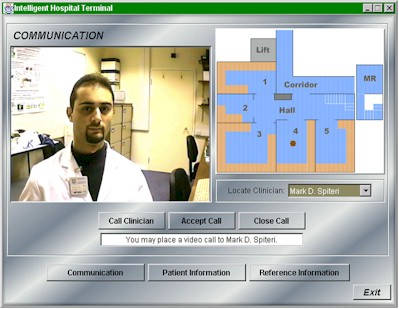
|
|
||||||||

The QoS Dream Project - the Intelligent Hospital
Hospital clinicians deal with many patients in different locations and perform many different vital roles and functions. The aim of the QoS DREAM project is to build an experimental 'intelligent hospital' where computers have a real sense of what is going on and respond to the activities of clinicians.
Above all, clinicians must be available at all times, a requirement that currently relies on paging systems. QoS DREAM stands for Quality of Service for Dynamically REconfigurable and Adaptable Multimedia. In a QoS DREAM hospital, not only will the location of clinicians be known automatically, but they will have rapid access to powerful hospital resources ranging from patient information to live video links - wherever they are. For example, real time images of a patient and their vital signs data can be displayed along with medical records, while clinicians at different sites discuss a diagnosis using a remote multimedia link.

Screenshot from a demonstrator application.
Location information is at the heart of the system through small wearable Active Badges that emit unique infra-red signals, picked up by sensors throughout the hospital. In addition, high-bandwidth networks will link rooms equipped with cameras, microphones, loudspeakers and displays. When the clinician moves around the hospital, he or she may want to have continuous visual access to information about intensive care patients. And since the system knows where the member of staff is at any time, it can deliver this information to the nearest display.
If an expert opinion is sought urgently, clinicians can engage in a video conference that continues from room to room by making the video images and sound simply 'follow' the participants around. Furthermore, medical students or other relevant parties can accompany the clinician as virtual observers, avoiding the common sight of large groups of people in white coats huddled around an anxious patient.
The project is in the early stages but the team at the LCE is already working with staff at Addenbrookes Hospital in Cambridge and it is hoped to develop a trial system for evaluation next year. Underlying the project are two innovative technologies: event-driven programming and dynamic media distribution. Event-driven programming is a fast and simple method of writing software by tying together independent programs over a network. Programs ask to be 'notified' whenever interesting events occur in other programs and this triggers them to take some action. Dynamic media distribution provides audio and video links with guaranteed quality across conventional computer networks and the links are re-configured smoothly as users move from point to point.